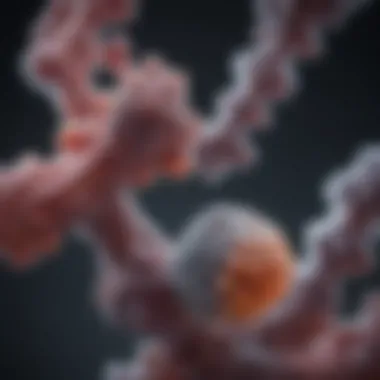Inheritance Patterns of Congenital Adrenal Hyperplasia


Intro
Congenital adrenal hyperplasia (CAH) presents a significant challenge within the realm of endocrinology and genetics. It’s a condition rooted in the body’s ability to produce adrenal hormones effectively. Understanding the intricacies of this disorder requires a comprehensive look into the genetic mechanisms that underpin its inheritance, the biochemical disruptions involved, and the real-world implications for families affected.
At its core, CAH arises from mutations in genes responsible for producing enzymes that help synthesize vital hormones. This article endeavors to break down these genetic inheritance patterns, highlighting how these mutations manifest in the population, their implications for affected individuals, and the critical importance of genetic counseling.
The relevance of this topic is profound. As researchers and clinicians delve deeper into the genetic landscape of CAH, there is a pressing need for clear communication about how these genetic variants pass from parents to their children. In an age where precision medicine is becoming increasingly prominent, the role of genetic studies cannot be overstated.
Through this comprehensive guide, we aim to shed light on the latest findings related to CAH and provide a valuable resource for students, researchers, educators, and professionals keen on broadening their understanding of this condition.
Overview of Congenital Adrenal Hyperplasia
Congenital adrenal hyperplasia (CAH) is a complex and multifaceted disorder that lies at the intersection of genetics and endocrinology. Understanding CAH is crucial, as it provides insights into both its clinical repercussions and inheritance mechanisms. The significance of this overview lies not just in presenting facts, but in framing CAH as a condition that affects countless individuals and their families worldwide, drawing connections to broader implications for genetic counseling and risk assessment.
Definition and Classification
Congenital adrenal hyperplasia refers to a group of inherited disorders affecting the adrenal glands, critical players in hormone production. When these glands are defective, it can lead to improper hormone levels, often resulting in adrenal insufficiency. The most common form of CAH is due to a deficiency in the enzyme 21-hydroxylase, which impairs the synthesis of cortisol and aldosterone. This deficiency results in an accumulation of steroid precursors, which can have significant biological effects.
CAH isn’t a one-size-fits-all as it comes in a few different forms, mainly classified based on severity:
- Classic CAH: Presents in infancy with severe symptoms.
- Non-classic CAH: Milder form that might not show signs until later in childhood or adulthood.
Due to the genetic variations that lead to CAH, classification also extends into specific genetic mutations, offering a more in-depth understanding of the condition and potential interventions.
Epidemiology and Prevalence
The prevalence of congenital adrenal hyperplasia varies, but it is often seen in about 1 in 15,000 births, though this statistic can change based on geographic and ethnic factors. For example, in certain populations, such as those of Mediterranean descent, the prevalence can be as high as 1 in 2,000.
It’s also important to note that CAH presents differently in various demographic groups. Certain genetic backgrounds may predispose populations to a higher incidence of condition. Generally, understanding the epidemiology of CAH involves looking at:
- Risk Factors: Including family history and ethnic background.
- Impact on Population Health: Affecting not just individuals but also healthcare systems and educational resources, as well as the support and counseling needed for families affected by CAH.
As we delve deeper into the genetic foundations, recognizing the prevalence and classification of CAH builds a foundation for understanding the inheritance patterns that play a critical role in how this disorder can manifest in future generations. By dissecting these components, it’s easier to see why continued research and awareness are vital in tackling the challenges posed by congenital adrenal hyperplasia.
Genetic Basis of Congenital Adrenal Hyperplasia
The genetic underpinnings of congenital adrenal hyperplasia (CAH) are crucial if we hope to effectively understand its transmission and clinical impacts. These insights enable researchers and clinicians alike to delineate the mechanisms through which specific mutations disrupt hormonal balance in affected individuals. Through a detailed examination of how genetic variations tie into phenotype, we can appreciate both the biological derangements and the implications for management and counseling. Such understanding not only informs treatment strategies but also equips families with the knowledge needed to navigate their unique circumstances.
Key Genes Involved
At the heart of CAH are crucial genes that carry the burden of responsibility for this condition. Primarily, the CYP21A2 gene is the key player. It encodes the enzyme 21-hydroxylase, critical in the pathway for producing cortisol and aldosterone from cholesterol. When mutations occur here, cortisol production may be reduced, leading to a compensatory increase in androgens that may affect physical development.
Moreover, variations of this gene significantly influence the severity of the condition. There are several mutation types:
- Non-functional mutations: Result in severe CAH, leading to a total loss of enzyme activity.
- Partial loss mutations: Cause a milder form of CAH where some enzyme activity remains.
- Variant mutations: Present a spectrum that affects presentation and management.
In addition to CYP21A2, other genes like CYP11B1 and HSD3B2 are also associated with less common types of CAH. While CYP11B1 mutations can lead to a more complex adrenal enzymatic dysfunction known as cortisol-producing adrenal adenomas, the role of HSD3B2 is significant in adrenal steroidogenesis dysfunctions.
Understanding these genes is foundational, as it directly influences diagnosis, genetic counseling, and the way health professionals address the needs of patients.
Pathophysiology of Genetic Mutations
Delving into the pathophysiological implications of genetic mutations, we find that the repercussions are not merely biochemical; they resonate throughout multiple systems and life stages. The enzymes affected are cornerstones in the hormonal synthesis pathways, particularly for adrenal steroids. When enzyme activity is insufficient, it can disrupt normal feedback loops within the hypothalamic-pituitary-adrenal axis. In simpler terms, this means that each time the body tries to regulate stress or maintain equilibrium, it gets thrown off course.
This cascade often results in excessive production of androgens, which can lead to significant male-like characteristics in females, a phenomenon termed virilization. In males, overproduction can lead to premature puberty and associated risks of fertility complications later in life. The feedback errors can even be likened to a faulty thermostat in a climate control system: when one aspect fails, the entire environment can be thrown askew.
"The intricate balance of hormonal pathways can be compared to a well-orchestrated symphony; when one instrument misfires, the music becomes chaotic."
Familial patterns are also observed, as the autosomal recessive inheritance pattern means that both parents must carry a mutated gene for their offspring to manifest symptoms. Understanding this pattern allows for meaningful discussions on potential risks between family members and future generations. Ultimately, studying these genetic and physiological angles helps medical professionals to offer targeted treatments and consider appropriate interventions.
In summation, the genetic foundation of CAH not only highlights key players but also elucidates the broader biological ramifications of such mutations, thereby illuminating the path toward effective management strategies.
Inheritance Patterns in Congenital Adrenal Hyperplasia


Inheritance patterns play a fundamental role in understanding congenital adrenal hyperplasia (CAH). They elucidate how traits associated with this condition are passed from parents to offspring, especially given that CAH is primarily caused by genetic mutations that follow specific inheritance mechanisms. Recognizing these patterns not only helps identify risks for future generations but also aids in the provision of accurate genetic counseling. As health professionals and families work together, understanding these nuances can significantly influence management strategies and decision-making processes.
Autosomal Recessive Inheritance
Congenital adrenal hyperplasia is predominantly inherited in an autosomal recessive pattern. This means that two copies of an abnormal gene must be present for the disease to manifest. In a family, each parent carries one copy of the mutated gene—known as a carrier—but typically does not exhibit symptoms of the disorder. As a result, an offspring has several potential genetic combinations:
- Normal (no mutation): 25% chance (inheriting normal genes from both parents)
- Carrier (one mutated gene): 50% chance (inheriting one normal gene and one mutated gene)
- Affected (two mutated genes): 25% chance (inheriting mutated genes from both parents)
This pattern emphasizes the critical need for genetic testing and counseling, especially when both parents are known carriers. Understanding this inheritance pattern is not merely academic; it is deeply relevant for families as they navigate reproductive choices and management plans. Knowing that CAH is more likely to occur when both parents are carriers allows families to make informed decisions regarding prenatal screening and preparations for potential diagnoses.
Carrier Parents and Offspring Risks
When both parents are carriers of the CAH-related gene mutation, the risk of having an affected child becomes a pressing concern. This section delves into the implications of such genetic backgrounds.
The parents might not show any signs of the disorder, yet they could unknowingly pass the risk to their kids. Each pregnancy presents a 25% chance of having a child affected by CAH, underscoring the importance of genetic awareness.
For families with a prior history of CAH, understanding risks is crucial:
- Preconception Counseling: Engaging with genetic counselors to understand risks allows for informed family planning.
- Prenatal Testing: Options may include chorionic villus sampling (CVS) or amniocentesis, allowing for early detection of genetic conditions in the developing fetus.
- Emotional Preparedness: Families benefit from psychological support as they prepare for the possibility of raising a child with a chronic health condition.
While dealing with genetic concerns can be daunting, adequate knowledge can empower families to cope with potential hurdles. As the field of genetics progresses, advancements in technologies may provide clearer insights that not only refine understanding but also enhance the quality of life for those affected by CAH.
Clinical Manifestations of Congenital Adrenal Hyperplasia
Congenital adrenal hyperplasia (CAH) is a condition that affects the body's adrenal glands, leading to hormone imbalances. Understanding the clinical manifestations is pivotal for several reasons. First off, recognition of symptoms can lead to timely diagnosis and effective management. Moreover, the manifestations can vary significantly between males and females, providing crucial insights into the genetic and hormonal influences inherent to this disorder.
Symptoms in Males vs. Females
In many cases, the symptoms associated with CAH present differently based on gender. Male infants with CAH might show signs such as ambiguous genitalia, which can be a clear indicator of a hormonal imbalance. In contrast, females often present with what is termed virilization, which includes potentially male-pattern characteristics like facial hair growth and a deepened voice, all stemming from elevated androgen levels.
- Male Symptoms:
- Female Symptoms:
- Ambiguous genitalia at birth
- Early onset of puberty
- Potential fertility issues later in life
- Ambiguous genitalia or enlarged clitoris
- Irregular menstruation
- Infertility due to elevated androgens
The sex-specific symptoms highlight the necessity for tailored approaches in diagnosis and treatment for individuals with CAH. Prompt identification of these signs can influence health outcomes, particularly in terms of physical development and psychological well-being.
Diagnostic Challenges
The landscape of CAH diagnosis is fraught with challenges. One major hurdle is the variability in clinical presentation. Symptoms may not become apparent until later in childhood or adulthood, complicating early detection. Many healthcare settings may not routinely screen for CAH, leading to a diagnostic gap.
Furthermore, the symptoms can mimic those of other conditions, making it harder for healthcare providers to pinpoint the disorder without appropriate testing. This is especially true for females who may show symptoms of adrenal insufficiency or polycystic ovary syndrome, further obscuring the underlying CAH diagnosis.
- Key Diagnostic Challenges:
- Variability in symptoms between genders
- Similarities with other health disorders
- Lack of routine screening in some healthcare systems
Ultimately, a robust understanding of clinical manifestations fosters better awareness among healthcare professionals and ensures more prompt and accurate diagnosis, paving the way for more effective treatment pathwaays.
Diagnosis of Congenital Adrenal Hyperplasia
Diagnosing congenital adrenal hyperplasia (CAH) is a cornerstone in managing the disorder effectively. Early and accurate diagnosis is pivotal because CAH can lead to various complications if left untreated. By identifying the condition at its onset, healthcare providers can implement timely interventions that can significantly improve the quality of life for affected individuals.
The complexity of CAH's clinical presentation often necessitates a multifaceted approach to diagnosis, encompassing biochemical tests, genetic evaluations, and clinical assessments. Screening methods serve as the frontlines in detecting this condition, enabling healthcare professionals to identify at-risk populations and manage symptoms effectively.
Screening Methods
Newborn screening is the most recognized method for diagnosing CAH. This process typically involves measuring levels of 17-hydroxyprogesterone (17-OHP) in a blood sample taken shortly after birth. Elevated 17-OHP indicates potential adrenal dysfunction, prompting further tests for confirmation. The benefits of this method include:
- Early Identification: Parents can begin treatment immediately, reducing the risk of adrenal crisis.
- Accessibility: Newborn screening programs are widely implemented, ensuring that most infants are tested.
- Cost-Effectiveness: Early detection can prevent severe complications, ultimately lowering healthcare costs.
Other diagnostic tools can include genetic testing to detect specific mutations in genes that are known to cause CAH, such as the CYP21A2 gene. In specific cases, imaging studies might also be considered to assess adrenal gland structure and function.
Importance of Early Detection


The importance of early detection of CAH cannot be overstated. Prompt intervention can prevent life-threatening complications. Once a diagnosis is confirmed, a management plan can be established, which may involve:
- Hormonal treatments to replace deficient hormones.
- Monitoring growth and development to ensure proper health outcomes.
- Ongoing education for families about the condition.
Furthermore, early detection lays the groundwork for effective genetic counseling. Families can understand the inheritance patterns and potential implications for future pregnancies, which can help lift some of the uncertainty surrounding CAH.
"Early detection and intervention can alter the course of the disease significantly, fostering better health outcomes and life quality for individuals with CAH."
By highlighting screening methods and the importance of early detection, this section underscores the necessity of vigilance in recognizing and managing congenital adrenal hyperplasia. Awareness and education about the potential for CAH can pave the way for better prevention strategies and healthier lives.
Management and Treatment Options
The management and treatment of congenital adrenal hyperplasia (CAH) plays a pivotal role in the lives of affected individuals. Given that CAH stems from enzyme deficiencies in the adrenal glands, which results in imbalanced hormone production, effective treatment strategies are crucial. These strategies not only help manage the symptoms but also mitigate potential complications arising from the disorder. A comprehensive understanding of available options can enhance the quality of life for patients and their families.
Hormonal Replacement Therapy
Hormonal replacement therapy is often the cornerstone of treatment for individuals with CAH, particularly for those with the classic form of the condition. This therapy aims to correct the hormonal imbalances caused by enzyme deficiencies, allowing for normal physiological functions and development.
- Types of Hormones:
- Glucocorticoids: Cortisol is the main glucocorticoid used in therapy. It helps control the body's response to stress and regulates metabolism.
- Mineralocorticoids: Aldosterone is another crucial hormone. It plays a key role in regulating sodium and potassium levels, which are vital for maintaining blood pressure.
The dosage of these hormones is tailored to the individual's needs, often requiring adjustments based on age, growth, and specific symptoms. Regular monitoring through blood tests is essential to ensure the right levels are maintained, which helps to avoid both under-treatment and over-treatment, each bringing its own set of challenges.
Hormonal therapy has several benefits, including:
- Symptom Management: Proper treatment can effectively reduce the symptoms associated with CAH, such as ambiguous genitalia in girls or adrenal crises in both genders.
- Physical Development: This therapy supports normal growth and sexual maturation, which can significantly impact psychological development in children and adolescents.
- Preventing Complications: With appropriate management, many complications associated with CAH, such as cardiovascular issues and infertility, can be minimized or avoided.
However, there are considerations to bear in mind. Long-term use of glucocorticoids may lead to side effects, such as weight gain, osteoporosis, and mood changes. Proper counseling and regular follow-ups with healthcare providers are vital in navigating these challenges.
Role of Surgical Interventions
In certain cases, surgical interventions may become necessary, particularly for females who are born with ambiguous genitalia due to CAH. Surgery can help align the individual’s physical appearance with their gender identity and improve psychosocial outcomes.
- Types of Surgical Procedures:
- Genital Reconstruction: This may involve surgical correction of the genital structure to provide a typical appearance. It is often recommended based on the individual’s and family's preferences and clinical assessments.
- Fixation of the Vagina: For some patients, vaginoplasty may be necessary if there are concerns about vaginal development.
Surgical options tend to invite a variety of opinions, primarily around timing and necessity. Decisions tend to involve input from endocrinologists, pediatricians, surgeons, as well as the patient and family, ensuring that the chosen path aligns with the individual’s physical and psychological needs.
It's crucial to discuss potential risks and benefits with a qualified healthcare team. Parents should receive counseling not just about the medical aspects but also the potential emotional impacts of surgery. A holistic approach helps families make informed decisions that support both physical health and emotional well-being.
"Effective management of CAH is not just about medical treatment but involves navigating social and psychological landscapes as well."
Genetic Counseling for Families
Genetic counseling is a critical component for families dealing with congenital adrenal hyperplasia (CAH). When faced with a diagnosis, understanding the implications of genetic inheritance patterns can be overwhelming. Counselors provide valuable information that can guide families through the maze of complex decisions associated with CAH.
In the context of CAH, genetic counseling involves educating families about the nature of the genetic mutations affecting hormone production. Given the autosomal recessive inheritance pattern of most CAH cases, it is vital for parents to understand their own carrier status. Identifying carriers helps assess the risk of having children with CAH, and ultimately aids in planning any necessary interventions.
Importance of Genetic Testing
Genetic testing serves as a cornerstone in the management of CAH. The ability to pinpoint specific mutations allows for early diagnosis and appropriate management of the condition. By conducting tests on both parents and children, professionals can identify carrier status and potential health implications.
- Early Intervention: With early testing, clinicians can begin treatment sooner, which may include hormonal therapies that mitigate complications stemming from CAH.
- Informed Family Planning: Families can make educated choices regarding future pregnancies. Understanding the genetic risk can facilitate prenatal testing options.
- Tailored Management: Knowing the exact genetic mutation helps in customizing treatment plans since different mutations may present varying degrees of severity.
"Knowledge is power; when it comes to health, it’s also the key to peace of mind."
Addressing Psychological Concerns
The diagnosis of CAH does not only entail medical implications but also substantial psychological considerations for families. The weight of knowing that a child has a genetic condition can be daunting. Genetic counselors play an important role in mitigating these concerns through ongoing support and education.
- Emotional Support: Counselors often provide a platform for parents to express their fears and anxieties. This support can alleviate feelings of isolation, as families learn they’re not navigating this journey alone.
- Understanding the Condition: Educating families about CAH can help normalize their experiences. Knowledge about the condition aids in demystifying fears surrounding it.
- Coping Strategies: Counselors can offer strategies to help families cope with daily challenges posed by the condition, emphasizing resilience and adaptability.


Through comprehensive genetic counseling, families encountering CAH can glean not only vital information but also emotional sustenance. This holistic approach ensures that both the medical and psychological facets of CAH are cohesively addressed, fostering a supportive environment for affected families.
Research Advances in Congenital Adrenal Hyperplasia
Research into congenital adrenal hyperplasia (CAH) is pivotal, not just for understanding the condition itself, but also for reimagining treatment methodologies. With its genetic backdrop, the advances in research hold the promise of tailoring therapies to individual patients, enhancing their quality of life, and addressing the wide-ranging implications of CAH on health.
Fundamentally, investigating CAH ties into broader discussions about genetic disorders and the efficacy of personalized medicine. Innovations here are setting the stage for a more robust grasp of the disease's nuances, which is particularly vital given its complexity and the variability in presentation among affected individuals. This section captures critical themes surrounding ongoing studies, emerging treatments, and future considerations that can influence CAH management.
Emerging Genetic Therapies
Recent breakthroughs in genetic therapies for CAH are lighting a path toward potentially transformative treatments. One notable avenue is gene therapy, a concept wherein faulty genes are corrected or replaced to restore their normal function. Research suggests that using viral vectors to deliver healthy copies of genes responsible for producing essential enzymes might mitigate or even eliminate some symptoms associated with CAH.
Here are some promising elements of emerging genetic therapies for CAH:
- CRISPR-Cas9 Technology: This gene-editing tool is revolutionizing how researchers approach genetic disorders. By precisely targeting and altering defective genes, CRISPR could effectively address the root cause of CAH.
- Ex Vivo and In Vivo Therapies: Techniques that either modify cells outside the body and reintroduce them, or directly edit genes within a patient’s body, show promise in future CAH treatments.
- Targeted Enzyme Replacement: This involves supplementing the body with enzymes that are deficient due to genetic mutations, providing a stopgap solution until more permanent corrections can be made.
As these therapies progress, key considerations must remain in the spotlight, especially concerning long-term effects and ethical implications. Rigorous testing of safety and efficacy is crucial, ensuring that patients are not put at undue risk while pioneering these avant-garde approaches.
"The potential to alter the course of congenital adrenal hyperplasia through genetic therapies heralds a new age in endocrine management, offering hope where previously none existed."
Future Directions
The future landscape of research in congenital adrenal hyperplasia appears rich with possibilities as scientists and clinicians collaborate to push the boundaries of what's achievable. Several promising directions include:
- Increased Understanding of Metabolic Pathways: A deeper dive into the biochemical pathways involved in steroidogenesis could unveil new targets for intervention and lead to alternative treatment paradigms.
- Biomarker Discovery: Identifying specific biomarkers associated with distinct CAH phenotypes can facilitate earlier diagnosis and better patient stratification for tailored therapies.
- Longitudinal Studies: Ongoing studies monitoring long-term health outcomes among CAH patients will be valuable in assessing the effectiveness of emerging therapies and refining management protocols.
- International Collaboration: Sharing data and resources among global research teams can accelerate the pace of discovery and innovation, leveraging diverse populations to enhance generalizability of findings.
All these directions intermingle, crafting a narrative that speaks to the future of CAH research. By harmonizing efforts towards innovation and understanding, stakeholders can forge a path that elevates not just theoretical comprehension, but practical applications that vastly improve lives impacted by congenital adrenal hyperplasia.
Case Studies and Patient Experiences
Case studies and real-life patient experiences play a crucial role in understanding congenital adrenal hyperplasia (CAH), as they provide concrete illustrations of how genetic inheritance impacts individuals and families. These narratives add depth to medical knowledge, offering insights that extend beyond clinical data and statistics.
Real-life Impacts of Inheritance
The inheritance patterns of CAH can often lead to varied outcomes depending on numerous factors, including genotype and environment. For instance, consider a family where both parents are carriers of a genetic mutation. They might have several children, some who develop the classic form of CAH and others who present with mild forms or may not show symptoms at all.
Such diversity in presentations illustrates the unpredictable nature of the condition and the necessity for thorough genetic counseling. In one case, a young girl exhibited signs of early adrenal insufficiency, which was traced back to a 21-hydroxylase deficiency inherited from her parents. Through her story, healthcare practitioners understood the emotional toll of early diagnosis, treatment initiation, and the long-term implications for her development.
Thus, documenting these personal accounts can highlight themes of resilience, adaptation, and the complex emotional landscape that accompanies life with CAH.
Long-term Health Outcomes
Understanding the long-term health outcomes of individuals with CAH is vital for both clinical practice and family planning. Patients often experience challenges related to their disease that can span beyond childhood and into adulthood. For instance, one individual shared their struggles with hormonal imbalances and the crucial role of ongoing hormonal therapy in maintaining health.
Important factors that influence these health outcomes include:
- Adherence to treatment: Regular follow-ups and compliance with medication can prevent acute adrenal crises.
- Psychological Effects: Many patients face anxiety related to symptoms or complications of CAH, which can particularly affect quality of life in adolescence and adulthood.
- Reproductive Health: There are implications for fertility and sexual health as well, varying widely between sexes and from individual to individual.
Longitudinal studies and case reports illustrate that with proper management, many patients can lead fulfilling lives, but they often have to navigate a more complex healthcare landscape.
"CAH shaped my life in unforeseen ways, but I've learned to manage it with the right support and treatments," noted one patient, showcasing that while challenges exist, progress and adaptation are possible.
Sharing these detailed experiences informs healthcare providers and families alike, emphasizing the necessity for individualized care strategies and the importance of emotional and psychological support systems. By focusing on these case studies, healthcare professionals can tailor their approaches more effectively, ultimately enhancing patient outcomes in CAH management.
Closure and Summary of Findings
In closing, the study of congenital adrenal hyperplasia (CAH) reveals intricate layers of genetic and clinical ramifications intertwined with inheritance patterns. This article highlighted the significance of understanding the genetic inheritance mechanisms of CAH, because recognizing these patterns can influence how families prepare for and manage the condition. The findings underscore that genetic mutations leading to varied forms of CAH carry implications not just for those diagnosed, but also for their relatives who may be carriers or at risk.
The insights provided delve into the various inheritance patterns, particularly focusing on the autosomal recessive nature of many CAH cases. It’s imperative to acknowledge that the risks faced by offspring of carrier parents can be quantitatively assessed through genetic counseling, shedding light on potential outcomes and empowering families with knowledge. Understanding these dynamics can promote better health outcomes through proactive measures.
Investing in future research directions is essential. By fostering studies that explore deeper genetic interactions and their physiological consequences, scientists can pave the way for more effective therapies. Increasing our comprehension surrounding the genetic underpinnings of CAH may also allow for novel approaches in gene therapy, opening new avenues for treatment.
"As science advances, the knowledge gleaned about genetic conditions aids not only in treatment but also in the emotional and psychological preparedness of affected families."
Implications for Future Research
Future research must focus on a multifaceted approach. Investigating the specific pathways disrupted by genetic mutations could yield insight into interaction networks that contribute to CAH's manifestation. A closer examination of the hormonal feedback loops involved in adrenal function may hold keys to improved management strategies for patients.
Moreover, exploring the psychosocial impact on families living with CAH is equally crucial. Understanding how genetic uncertainties affect family dynamics, relationships, and mental health can drive the development of comprehensive support frameworks. This holistic perspective ensures that the emotional and social aspects of living with CAH are not overlooked alongside the clinical diagnosis and treatment.
Final Thoughts on Genetic Counseling
Genetic counseling emerges as an indispensable element in the discourse surrounding congenital adrenal hyperplasia. It acts as a bridge between complex genetic concepts and families seeking clarity about their situations. Counselors provide not only factual information regarding inheritance risks but also emotional support, facilitating discussions about family planning and the implications of genetic testing.
The value of genetic counseling lies in its potential to mitigate anxiety that often accompanies the uncertainty of genetic conditions. Talk about CAH can evoke fears regarding the future, financial implications, and health consequences. Therefore, genetic counselors play a critical role in helping families understand the scope and significance of CAH comprehensively.
In summary, as both the medical and genetic landscapes evolve, continuous engagement with genetic counseling will remain essential. Through effective communication and empowerment of families, we can transform the challenges posed by congenital adrenal hyperplasia into opportunities for informed decision-making and better health outcomes.







